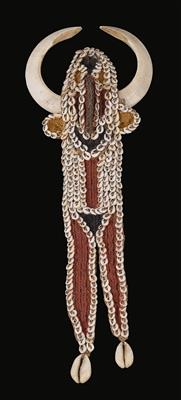New Guinea: Area of Maprik hills, Tribes: Abelam, Wosera, Arapesh. Male ornament, called a ‘kara-ut’.
New Guinea: Area of Maprik hills, Tribes: Abelam, Wosera, Arapesh. Male ornament, called a ‘kara-ut’.

A typical ‘kara-ut’ pendant for men, from the Maprik hills in northern New Guinea. The basic form consists of tightly plaited vegetable strings dyed red, black and yellow and densely trimmed with small nassa sea snails. At the top, two large boar tusks are incorporated on the left and right. The two projections on the bottom each have a cowry shell dangling from them.
A ‘kara-ut’ represents an ancestor. Its face is clearly depicted at the top (with eyes, nose, mouth and ears), including its broad headdress (the boar tusks). Its body is the centre, while the two projections at the bottom represent the legs.
The ‘kara-ut’ was worn in peacetime by initiated men as an amulet on a band on their back (never on their chest). In war and during battle, however, the ‘kara-ut’ was worn on their faces, in their mouths, jammed between their teeth. Just as if the boar tusks were growing from the mouth of the warrior, who thereby portrayed a terrifyingly fierce boar.
First half of the 20th century; L: 36 cm. (ME)
Provenance: Viennese Private Collection.
Lit.: ‘Schmuck der Südsee’, by Ingrid Heermann & Ulrich Menter, ill. 26.
Specialist: Erwin Melchardt
 Erwin Melchardt
Erwin Melchardt
+43-1-515 60-465
erwin.melchardt@dorotheum.at
26.05.2015 - 15:00
- Estimate:
-
EUR 500.- to EUR 800.-
New Guinea: Area of Maprik hills, Tribes: Abelam, Wosera, Arapesh. Male ornament, called a ‘kara-ut’.
A typical ‘kara-ut’ pendant for men, from the Maprik hills in northern New Guinea. The basic form consists of tightly plaited vegetable strings dyed red, black and yellow and densely trimmed with small nassa sea snails. At the top, two large boar tusks are incorporated on the left and right. The two projections on the bottom each have a cowry shell dangling from them.
A ‘kara-ut’ represents an ancestor. Its face is clearly depicted at the top (with eyes, nose, mouth and ears), including its broad headdress (the boar tusks). Its body is the centre, while the two projections at the bottom represent the legs.
The ‘kara-ut’ was worn in peacetime by initiated men as an amulet on a band on their back (never on their chest). In war and during battle, however, the ‘kara-ut’ was worn on their faces, in their mouths, jammed between their teeth. Just as if the boar tusks were growing from the mouth of the warrior, who thereby portrayed a terrifyingly fierce boar.
First half of the 20th century; L: 36 cm. (ME)
Provenance: Viennese Private Collection.
Lit.: ‘Schmuck der Südsee’, by Ingrid Heermann & Ulrich Menter, ill. 26.
Specialist: Erwin Melchardt
 Erwin Melchardt
Erwin Melchardt
+43-1-515 60-465
erwin.melchardt@dorotheum.at
|
Buyers hotline
Mon.-Fri.: 10.00am - 5.00pm
kundendienst@dorotheum.at +43 1 515 60 200 |
| Auction: | Tribal Art |
| Auction type: | Saleroom auction |
| Date: | 26.05.2015 - 15:00 |
| Location: | Vienna | Palais Dorotheum |
| Exhibition: | 20.05. - 26.05.2015 |
